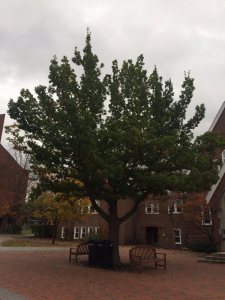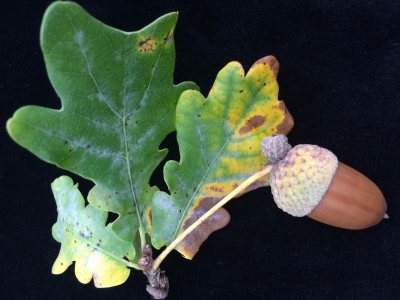English Oak
Quercus robur | Family: Fagaceae
Submission: Samantha Reiss ‘18
Natural History:
 “The oak, when living, monarch of the wood. The English oak, which, dead, commands the flood.” -Charles Churchill
“The oak, when living, monarch of the wood. The English oak, which, dead, commands the flood.” -Charles Churchill
The English oak (Quercus robur) was so highly valued by the English that it was brought to the New World in the 1700’s, where it easily established in the climate of the Northeastern United States. In Europe, the grand and resilient English oak can be traced back thousands of years through literature and art. The English oak appears in the writings of Tolkien and Shakespeare, as well as in the legend of Robin Hood, who reputedly sought refuge in a great, hollowed oak of Sherwood Forest. People believe they have identified this individual as a massive, gnarled English oak standing nearly 100 feet tall, with a hollowed trunk, and nearly 1000 years old. Humans have witnessed this tree endure extreme trauma, such as lightning strikes, which people of ancient Greece thought was Zeus communicating to them through the tree.
Until the domestication of modern cash crops like wheat and corn, humans relied on acorns as a source of carbohydrates in their diet. English oak produces sweet acorns, making them palatable for the human stomach, but not until it has matured to at least 40 years of age. Oak trees are also infamous for the high concentration of tannins produced in the bark, which have been used to tan leather. Other parts of English oak such as leaves,
galls, and acorns have been used as remedies to treat a variety of ailments ranging from kidney stones and inflammation to gingivitis and sore throats. Through time, the English has become valued for its beautiful, hard wood in the construction of musical instruments, ships and barrels.
English oak tends to be rather resistant to pests and disease, making it ideal for cross-breeding with fellow species of the white oak subgroup to foster greater resistance in other species. Similar to swamp white oak (Quercus bicolor), English oak is susceptible to the production of a powdery mildew on its leaves each mid to late summer. This mildew is caused by the same fungus that affects lilacs and roses, but is a cosmetic disease and causes no damage to the overall health and vigor of the tree. With its Latin name, Quercus robur, literally meaning “strength,” it stands to reason why this species has been able to maintain such a significant role in human history.

Identification:
Leaves – deciduous; similar to Q. alba but smaller with an auricular base
Buds – large and angled; somewhat pubescent
Fruit – borne on long (1” to 3”) stalks, very sweet
Bark – somewhat ash-like; silvery brown, increasingly fissured with age
Silvics – an intolerant, generally small tree; able to survive on dry, sterile sites; often with epicormic branches; found in New England, the mid-Atlantic coastal plain, and inland to the southern Appalachians.
References:
Brockman, C.F.. 1986. Trees of North America: A Guide to Field Identification. Revised Edition. Western Pub. Co., Inc. 280pp.
Elias, T.S. 1980. The Complete Trees of North America Field Guide and Natural History. Van Nostrand Reinhold Co., N.Y. 948pp.
Harlow, W.M., Harrar, E.S., Hardin, J.W. and White, F.M. 1991. Textbook of Dendrology. McGraw-Hill Inc., N.Y. 501pp.
Petrides, G.A. 1972. A Field Guide to Trees and Shrubs. 2nd edition. Houghton Mifflin Co., Boston. 428pp.
Preston, R.J., Jr. 1989. North American Trees. 4th edition. Iowa State Univ. Press. Ames. 407pp.
Shane, J. 2004. Dendrology Handbook, University of Vermont, Unpublished.
UVM Tree Profiles. (n.d.). Retrieved Oct. 30, 2017 from: http://ctl.w3.uvm.edu/omeka/exhibits/show/uvmtrees
Woodland Trust. (2017). Oak, English (Quercus robur).